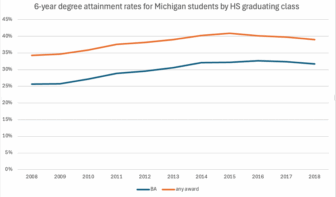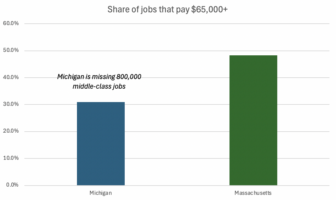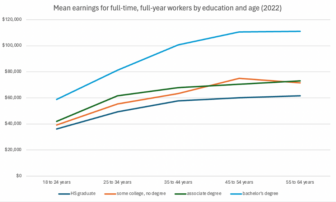Below is the 2011 employment rate (employment to population ratio) data for 25-64 years olds –– the prime working years –– for Michigan’s three largest metropolitan areas: the nine county Detroit region (including Ann Arbor and Flint), the seven county metro Grand Rapids/Holland/Muskegon region, and the four country metro Lansing region.
The employment rate is a better measure than the unemployment rate because it takes off the table those who are too discouraged to look for work and therefore are not counted. Its a straight forward measure of within a cohort what proportion have a job .
Just as with the national and state data we explored in my last post, those with a four year degree have the highest proportion working. And the proportion of those working goes up with each step of the education attainment ladder. In each region demand is highest for those with four year degrees or more. In none of Michigan’s big metros do we have too many college grads. Also we do not have more demand in any of them for so-called mid-skill occupations for those with some college or an associates degree. In the state as a whole as well as our three largest metros the data are clear: if you want to work the best path is a four year degree or more.
Metro Grand Rapid’s employment rate at each level of education attainment mirrors the nation’s and is higher than that of Michigan or metro Detroit and Lansing. Metro Detroit –– and as we saw in the last post for the entire state –– have particularly low employment rates for those without a high school degree.
The pattern for Michigan’s three big metros is repeated nationally. Don Grimes and I have been looking at data for the big metros across the country. Everywhere those with a four year degree have the highest proportion working and the proportion of those working goes up with each step of the education attainment ladder. What standouts is the consistency across the country of the employment rate for those with a four year degree or more in the low 80s. The difference between regions comes in the employment rate for those with less than a four year degree. The resulting total employment rate differences between regions is a combination of the rate for those with lower education attainment and the proportion of 25-64 year olds in each of the four categories.







